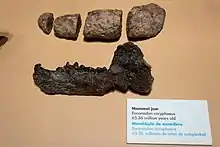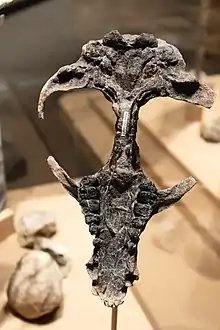Eoconodon
Eoconodon is an extinct genus of triisodontid mesonychian that existed during the early Paleocene of North America.[1] Characteristics of the genus include massive jaws, blunt builds, and strong canine teeth.[2]

E. coryphaeus jaw
| Eoconodon Temporal range: | |
|---|---|
 | |
| Eoconodon coryphaeus skull, Denver Museum of Nature and Science | |
| Scientific classification | |
| Domain: | Eukaryota |
| Kingdom: | Animalia |
| Phylum: | Chordata |
| Class: | Mammalia |
| Order: | †Mesonychia |
| Family: | †Triisodontidae |
| Genus: | †Eoconodon Matthew & Granger, 1921 |
| Type species | |
| †Eoconodon coryphaeus (Cope, 1885) | |
| Species | |
|
See text | |
Individuals were about the size of a modern house cat, but were considered giant for mammals at the time.[3]
Species
- Eoconodon copanus
- Eoconodon coryphaeus
- Eoconodon ginibitohia
- Eoconodon heilprinianus
- Eoconodon nidhoggi
References
- Clemens, William A. (2011). "Eoconodon ("Triisodontidae," Mammalia) from the Early Paleocene (Puercan) of northeastern Montana, USA" (PDF). Palaeontologia Electronica. 14.
- Clemens, William A.; Williamson, Thomas E. (2005). "A new species of Eoconodon (Triisodontidae, Mammalia) from the San Juan Basin, New Mexico". Journal of Vertebrate Paleontology. 25 (1): 208–213. doi:10.1671/0272-4634(2005)025[0208:ANSOET]2.0.CO;2.
- Michael Franco (June 20, 2016). "Over 90 percent of mammals were wiped out by dino-killing asteroid". Gizmag. Retrieved June 20, 2016.
This article is issued from Wikipedia. The text is licensed under Creative Commons - Attribution - Sharealike. Additional terms may apply for the media files.
